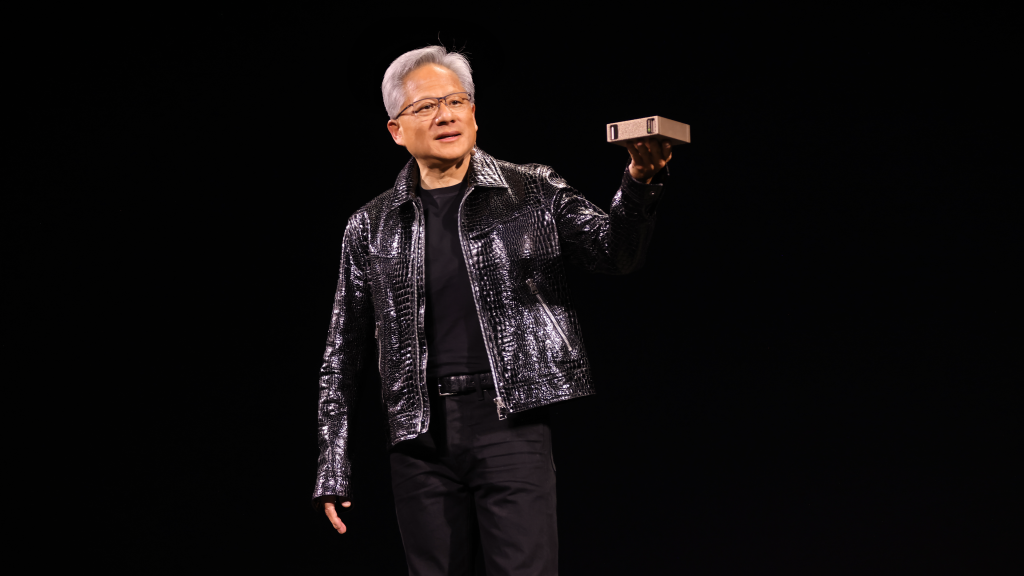Nvidia CEO Jensen Huang’s keynote at CES 2025 in Las Vegas outlined the company’s latest innovations, including the Cosmos platform and advances in Agentic AI, while sharing insights on the future of technology and enterprise applications.
Cosmos: a “ChatGPT moment” for robotics
At the annual tech gathering, Huang introduced the Cosmos platform, heralding it as a “ChatGPT moment” for robotics and autonomous systems.
This generative AI platform is designed to accelerate the development of physical AI systems, such as robots and autonomous vehicles (AVs), by providing powerful tools for simulation, training, and decision-making.
At its core, Cosmos integrates its World Foundation Models (WFMs) with generative AI capabilities to “generate high-fidelity, physics-aware video from simple inputs, simulating and predicting real-world outcomes for robotics and autonomous systems.”
These models enable developers to generate synthetic training data, simulate various scenarios, and enhance AI systems in the logistics, transportation, and manufacturing sectors.
Huang emphasised the platform’s capability to “ingest text, image, or video prompts and generate virtual world states as videos.”
This functionality makes it particularly suitable for physical AI applications, allowing for scenarios such as video search and understanding. Developers will be able to identify specific training scenarios, like snowy roads or warehouse congestion.
In a similar vein, synthetic data generation using Cosmos and Nvidia Omniverse allows developers to create photorealistic videos to train AI systems, eliminating the need for costly real-world data.
Leading robotics and AV companies, including Agile Robots, Waabi, XPeng, and Uber are already leveraging Cosmos to streamline development, reduce data scarcity challenges, and enhance safety and validation processes.
Agentic AI: transforming enterprise workflows
A recurring theme of Huang’s keynote was agentic AI, which he described as the next major evolution for enterprises.
These AI systems can perceive, reason, plan, and act autonomously, making them valuable assets in business environments.
“One of the most important things happening in the world of enterprise is agentic AI,” Huang remarked, highlighting how these systems will enable enterprises to perform complex tasks with greater efficiency.
Unlike traditional AI models, Agentic AI systems engage in internal reflection and reasoning, leading to higher-quality outcomes. “These inferences used to be one inference,” Huang said, “but in the future, the AI will be talking to itself. It’s going to be thinking.”
According to Huang, test-time scaling enabled by Agentic AI is another significant chatbot upgrade. Instead of relying solely on fixed model parameters, these systems dynamically allocate computational resources to optimise performance in real-time.
“The AI determines how much computation to use to generate the answers it needs,” Huang explained.
In the enterprise context, IT departments will be pivotal in managing these AI agents. Huang likened this responsibility to HR departments managing employees, saying, “In the future, they will maintain, nurture, onboard, and improve a whole bunch of digital agents and provision them to the companies to use.”
Nvidia’s leadership in AI infrastructure
Huang also underscored Nvidia’s commitment to providing the tools and infrastructure necessary to support these advances at CES 2025.
The Blackwell GPU system, unveiled during the keynote, is an example of this effort. With 1.4 exaflops of AI floating-point performance, the tech giant claims that Blackwell has been designed to handle the massive computational demands of both Cosmos and Agentic AI systems.
“Our goal is to create one giant chip,” Huang stated, emphasising Nvidia’s dedication to delivering scalable, high-performance solutions for AI developers.

Nvidia CEO, Jensen Huang
Additionally, Nvidia is making Cosmos WFMs widely accessible through open-model licenses.
Developers can preview these models on platforms like Hugging Face or customise them using Nvidia’s NeMo framework. This approach signifies Huang’s vision of democratising AI development and empowering the global developer community.
New era for robotics and autonomous systems
Beyond enterprise applications, Cosmos provides the capability to simulate and optimise physical interactions.
For instance, XPeng is utilising Cosmos to speed up the development of humanoid robots, Waabi is exploring Cosmos for the simulation of autonomous vehicles, while Agile Robots is taking advantage of Cosmos’ synthetic data generation features to enhance warehouse automation.
By addressing the challenges of data scarcity and variability, Cosmos enables faster, more cost-effective AI training and deployment.
As Huang put it, “Cosmos generations prioritise the unique requirements of AV and robotics use cases like real-world environments, lighting, and object permanence.”
Huang’s keynote at CES 2025 painted a future where humans and AI work together to achieve new levels of efficiency and innovation.
The rise of Agentic AI and platforms like Cosmos could signal a shift towards more collaborative, dynamic workplaces, where digital agents enhance human capabilities.